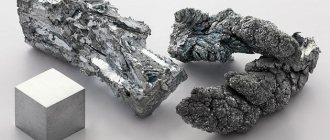Methods for producing alloys
Depending on the purpose of the alloys, the scale of production, the required degree of purity, the nature of the initial charge materials and economic considerations, zinc alloys can be produced in the following ways: direct alloying of pure metals, electrolytic coprecipitation of metals, replacement of one element with another in any compound, diffusion method using liquid substances.
The most common method for producing industrial zinc-based alloys is direct alloying of pure metals. The main advantages of the method are high productivity, the ability to obtain alloys of a given chemical composition with a minimum content of harmful impurities and with the necessary properties, and the possibility of using melting furnaces of various types and designs to prepare alloys.
In any case, based on the specific production conditions, when preparing various grades of zinc alloys, a given temperature-time regime and the most rational sequence of operations of the smelting process are established.
Pure primary pig metals, waste from own production, alloys, and cathode zinc in the form of sheets are used as charge materials in the production of zinc alloys by direct alloying. When loading charge materials, a certain sequence must be followed. As a rule, first, most of the pig zinc, which is part of the charge in the largest quantity, is melted. Then the remaining components of the alloy in pure form or from the alloy are introduced into the molten zinc, and after that the remaining part of the pig zinc is added to the melt.
The order of introduction of the components of zinc-based alloys is determined by their concentration in the alloy, as well as the physicochemical properties of the metals (melting point, density, degree of oxidation, elasticity value of their saturated vapor pressure, etc.). In this case, small amounts of alloying components, especially when they easily oxidize or evaporate (Li, Ca) or have high (more than 1000 ° C) melting points (Ti, Mn, Si), are introduced into the alloy in the form of intermediate alloys (alloys). Some low-melting metals (Pb, Sn), as well as magnesium, are introduced into the zinc melt last.
The method for producing zinc-based alloys by electrolytic coprecipitation of metals from melts is based on the joint precipitation of zinc and some metals at the cathode under the influence of direct electric current. The most widely used method is electrolytic coprecipitation when applying protective coatings and producing special zinc alloys. The condition for the joint discharge of two cations is the equality of their discharge potentials. The convergence of the discharge potentials of the ions of two metals is achieved by changing the concentration of cations in the electrolyte. However, to bring together the release potentials of two metals that differ significantly in their standard potentials, it is necessary to create large concentration gradients, which does not ensure the production of alloys of a given composition. Consequently, changing the concentration of metals in solutions of their simple salts can be a means of bringing the potentials closer only for metals with standard potentials close in magnitude.
However, co-deposition of two metals with significantly different standard potentials on the cathode can be achieved when a limiting current occurs for the more electropositive metal. An example of an alloy deposition where the more positive component is released at the limiting current is the co-precipitation of zinc and cadmium from a sulfate solution, the standard potentials of which are -0.76 and -0.4 V, respectively.
A more effective method for bringing the potentials of coprecipitated metals closer together is complexation. In this case, the magnitude of the potential shift is determined by the degree of dissociation of the complex ion. If the instability constant of a complex ion of an electropositive metal is less than the instability constant of an electronegative metal, then the discharge potentials become closer. In addition to ion activity, metal polarization is also used in complex formation. For example, the deposition of a copper-zinc alloy becomes possible when using cyanide solutions not only due to the greater strength of the [Cu(CN) 3] 2- ion than [Zn(CN)4] 2-, but also due to the greater degree of polarization of copper compared with the polarization of zinc in these solutions. The difference in the equilibrium potentials of zinc and cadmium in both acidic and cyanide solutions at the same concentration of these metals is about 0.3 V (the instability constants of complex zinc and cadmium ions are close). The Zn-Cd alloy precipitates in a cyanide solution, but does not precipitate in an acid solution. Co-precipitation of zinc and cadmium in a cyanide electrolyte is due to the higher polarization of cadmium than of zinc.
In the practice of electrochemical deposition of alloys, other complex electrolytes are used - pyrophosphate, ammonia, tartrate, citrate, etc. In electrochemical deposition, the chemical composition of the alloy deposited at the cathode depends primarily on the ratio of the concentration of metals in the solution. For a number of alloys of the Fe-Zn, Cd-Zn, Sn-Zn systems, a direct or close to direct relationship is observed between the ratio of the atomic fractions of metals in the alloy and the ratio of metal concentrations in solutions, expressed as their normalities.
| Alloys and ferroalloys Wholesale! Prompt delivery! Discounts up to 15% when ordering 100 thousand. rub.! runimet.clients.ru |
Important factors affecting the chemical composition of the alloy are also current density, electrolyte temperature and stirring intensity.
It should be noted that the technology for electrochemical production of many alloys has been developed recently. In some cases, electrolytic alloys differ markedly in structure and physical and chemical properties from alloys obtained by direct alloying.
Currently, the technology for producing more than 250 alloys, including those based on zinc, containing copper, tin, lead, nickel, cadmium, and cobalt, has been studied. For example, to obtain light shiny zinc coatings containing 2% Ni, it is recommended
After preparing the electrolyte, it is recommended to operate with a current density of 2-3 A/dm2 for 3-5 hours (3-10 A • h/l).
For the deposition of a zinc-nickel alloy with a high nickel content (15-25%), the following zinc ammonia electrolyte and operating mode are used:
Alloys of the Zn-Ni, Zn-Co systems can also be deposited from a pyrophosphate electrolyte.
The substitution method (metallothermic method) is sometimes used to introduce alloying elements in small concentrations into the zinc melt. The method is based on the difference in the affinity of zinc and alloying metals for elements such as oxygen, chlorine, and sulfur. Thermodynamic calculations based on the known values of the Gibbs energy for the formation of chlorides, oxides, sulfites from zinc and elements have shown that elements such as copper, lead, silicon, nickel can be reduced from the corresponding oxides, chlorides, sulfides with the formation of zinc-based alloys. The efficiency of alloying zinc alloys from various compounds using the substitution method is determined by the temperature-time conditions of the process and depends on the intensity of mixing of the melt, for example 2Zn + SiCl4 = 2ZnCi2+ Si.
The diffusion method for preparing zinc-based alloys is the basis of the hot-dip galvanizing process. This method has found wide industrial application and is quite well covered in the literature.
Depending on the purpose of the alloys, the scale of production, the required degree of purity, the nature of the initial charge materials and economic considerations, zinc alloys can be produced in the following ways: direct alloying of pure metals, electrolytic coprecipitation of metals, replacement of one element with another in any compound, diffusion method using liquid substances.
The most common method for producing industrial zinc-based alloys is direct alloying of pure metals. The main advantages of the method are high productivity, the ability to obtain alloys of a given chemical composition with a minimum content of harmful impurities and with the necessary properties, and the possibility of using melting furnaces of various types and designs to prepare alloys.
In any case, based on the specific production conditions, when preparing various grades of zinc alloys, a given temperature-time regime and the most rational sequence of operations of the smelting process are established.
Pure primary pig metals, waste from own production, alloys, and cathode zinc in the form of sheets are used as charge materials in the production of zinc alloys by direct alloying. When loading charge materials, a certain sequence must be followed. As a rule, first, most of the pig zinc, which is part of the charge in the largest quantity, is melted. Then the remaining components of the alloy in pure form or from the alloy are introduced into the molten zinc, and after that the remaining part of the pig zinc is added to the melt.
The order of introduction of the components of zinc-based alloys is determined by their concentration in the alloy, as well as the physicochemical properties of the metals (melting point, density, degree of oxidation, elasticity value of their saturated vapor pressure, etc.). In this case, small amounts of alloying components, especially when they easily oxidize or evaporate (Li, Ca) or have high (more than 1000 ° C) melting points (Ti, Mn, Si), are introduced into the alloy in the form of intermediate alloys (alloys). Some low-melting metals (Pb, Sn), as well as magnesium, are introduced into the zinc melt last.
The method for producing zinc-based alloys by electrolytic coprecipitation of metals from melts is based on the joint precipitation of zinc and some metals at the cathode under the influence of direct electric current. The most widely used method is electrolytic coprecipitation when applying protective coatings and producing special zinc alloys. The condition for the joint discharge of two cations is the equality of their discharge potentials. The convergence of the discharge potentials of the ions of two metals is achieved by changing the concentration of cations in the electrolyte. However, to bring together the release potentials of two metals that differ significantly in their standard potentials, it is necessary to create large concentration gradients, which does not ensure the production of alloys of a given composition. Consequently, changing the concentration of metals in solutions of their simple salts can be a means of bringing the potentials closer only for metals with standard potentials close in magnitude.
However, co-deposition of two metals with significantly different standard potentials on the cathode can be achieved when a limiting current occurs for the more electropositive metal. An example of an alloy deposition where the more positive component is released at the limiting current is the co-precipitation of zinc and cadmium from a sulfate solution, the standard potentials of which are -0.76 and -0.4 V, respectively.
A more effective method for bringing the potentials of coprecipitated metals closer together is complexation. In this case, the magnitude of the potential shift is determined by the degree of dissociation of the complex ion. If the instability constant of a complex ion of an electropositive metal is less than the instability constant of an electronegative metal, then the discharge potentials become closer. In addition to ion activity, metal polarization is also used in complex formation. For example, the deposition of a copper-zinc alloy becomes possible when using cyanide solutions not only due to the greater strength of the [Cu(CN) 3] 2- ion than [Zn(CN)4] 2-, but also due to the greater degree of polarization of copper compared with the polarization of zinc in these solutions. The difference in the equilibrium potentials of zinc and cadmium in both acidic and cyanide solutions at the same concentration of these metals is about 0.3 V (the instability constants of complex zinc and cadmium ions are close). The Zn-Cd alloy precipitates in a cyanide solution, but does not precipitate in an acid solution. Co-precipitation of zinc and cadmium in a cyanide electrolyte is due to the higher polarization of cadmium than of zinc.
In the practice of electrochemical deposition of alloys, other complex electrolytes are used - pyrophosphate, ammonia, tartrate, citrate, etc. In electrochemical deposition, the chemical composition of the alloy deposited at the cathode depends primarily on the ratio of the concentration of metals in the solution. For a number of alloys of the Fe-Zn, Cd-Zn, Sn-Zn systems, a direct or close to direct relationship is observed between the ratio of the atomic fractions of metals in the alloy and the ratio of metal concentrations in solutions, expressed as their normalities.
| Alloys and ferroalloys Wholesale! Prompt delivery! Discounts up to 15% when ordering 100 thousand. rub.! runimet.clients.ru |
Important factors affecting the chemical composition of the alloy are also current density, electrolyte temperature and stirring intensity.
It should be noted that the technology for electrochemical production of many alloys has been developed recently. In some cases, electrolytic alloys differ markedly in structure and physical and chemical properties from alloys obtained by direct alloying.
Currently, the technology for producing more than 250 alloys, including those based on zinc, containing copper, tin, lead, nickel, cadmium, and cobalt, has been studied. For example, to obtain light shiny zinc coatings containing 2% Ni, it is recommended
After preparing the electrolyte, it is recommended to operate with a current density of 2-3 A/dm2 for 3-5 hours (3-10 A • h/l).
For the deposition of a zinc-nickel alloy with a high nickel content (15-25%), the following zinc ammonia electrolyte and operating mode are used:
Alloys of the Zn-Ni, Zn-Co systems can also be deposited from a pyrophosphate electrolyte.
The substitution method (metallothermic method) is sometimes used to introduce alloying elements in small concentrations into the zinc melt. The method is based on the difference in the affinity of zinc and alloying metals for elements such as oxygen, chlorine, and sulfur. Thermodynamic calculations based on the known values of the Gibbs energy for the formation of chlorides, oxides, sulfites from zinc and elements have shown that elements such as copper, lead, silicon, nickel can be reduced from the corresponding oxides, chlorides, sulfides with the formation of zinc-based alloys. The efficiency of alloying zinc alloys from various compounds using the substitution method is determined by the temperature-time conditions of the process and depends on the intensity of mixing of the melt, for example 2Zn + SiCl4 = 2ZnCi2+ Si.
The diffusion method for preparing zinc-based alloys is the basis of the hot-dip galvanizing process. This method has found wide industrial application and is quite well covered in the literature.
Types of raw materials
The very name “colored” means the color of the metal. Some types, such as copper, have a distinct color tint. Such substances are important because of their properties and qualities, which are much different from ordinary iron.
Therefore, the production of non-ferrous metals and alloys is necessary to obtain qualitatively new compounds used in all industries.
An alloy is a mixture of metals. When two or more metals in a molten state are combined, a new material is formed that has almost the full range of properties possessed by the constituents of the alloy.
Non-ferrous metals are divided into several large groups:
- Heavy - this group includes copper, zinc, lead, tin.
- Lungs - this group is represented by magnesium, titanium, beryllium, calcium, strontium, aluminum, sodium, potassium, cesium.
- Noble - are the most expensive of non-ferrous metals, which are scarce in nature: platinum, gold, silver, osmium, ruthenium, rhodium, palladium.
- Minor substances are a group of substances that are also rare in nature. These include cobalt, cadmium, antimony, bismuth, and mercury.
- Refractory: manganese, tungsten, chromium, vanadium, tantalum.
- Rare earths.
- Absent-minded.
- Radioactive.









